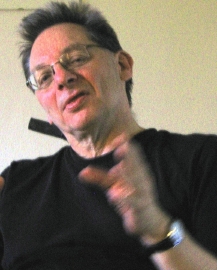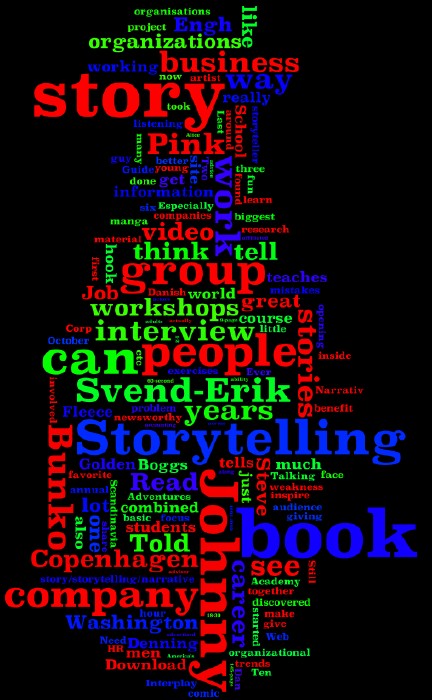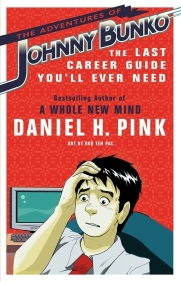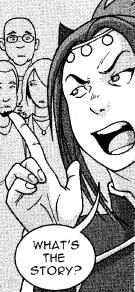
What a delight to present the fifth installment of my Q&A series with story practitioners. I have not actually met Svend-Erik Engh face to face, but have been in the same room with him during the Smithsonian Storytelling Weekends.
 Svend-Erik Engh is a noted Danish performing artist and experienced workshop leader. Born in Copenhagen in 1957, he started his career as a teacher at the Borups School for adults from 1993-1999. He tells stories professionally
Svend-Erik Engh is a noted Danish performing artist and experienced workshop leader. Born in Copenhagen in 1957, he started his career as a teacher at the Borups School for adults from 1993-1999. He tells stories professionally
— likes to tell under the branches of a copper beech in Kings Garden — and he teaches storytelling and organizes seminars, workshops and other events. He has been teaching storytelling for 20 years in universities, high schools and in business. He teaches at the Copenhagen Business School and at the University of Gotland. Showing that art and business can benefit from each other, he has conducted innovative workshops with organizations and companies throughout Scandinavia. Read his blog. He is the coordinator of the annual Golden Fleece Group’s Storytelling in Organizations Conference at the Copenhagen Business School, Denmark, which began in October 2007 and is an annual event (see below). You can learn more about Svend-Erik in Steve Denning’s interview with him, and if you read Danish, you can learn about him on his Web site. Svend-Erik’s most significant upcoming project is the Golden Fleece Copenhagen 2008, called StoryAtWork.dk, October 1-2, 2008, with Steve Denning, Madelyn Blair, Heather Forest, Mary Alice Arthur, Svend-Erik Engh, Mille Matjeka, and Marika Kajo. Download video. Svend-Erik is also the author of a fine little 145-page book, Tell a Story: Be Heard, Be Understood, Create Interaction, which can be ordered here. He offers a 9-page handout on being a better storyteller for download. Svend-Erik lives north of Copenhagen with his wife and three children. 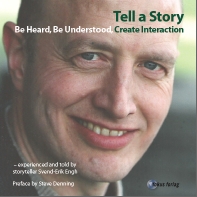
Svend-Erik Engh Q&A:
Q: In an interview with Steve Denning, you talk about having been a storyteller before 2000, then having a “wonderful experience” presenting to a group of organizational psychologists, and then becoming more and more involved in the “world of organizations.” Why do you think you were attracted to working with organizations? What was it about organizational work that drew you in?
A: I didn’t ask organisations — they asked me. I was invited by a lot of people to do presentations, workshops etc. And slowly I realized it was great fun. Especially when I kept focus on my role as an artist, and didn´t think I was a consultant.
It was so easy. I just did, what I have done for the past 10 years: Told people stories and learned them how to tell stories. I told my stories to show them how it could be done, to inspire. Then I gave them exercises like I had giving exercises to my students. Same exercises, same results: Stories gives energy, brings people together and it is great fun.
So now I am working for companies and as long I keep focus, it works for me. I inspire them to see their communication in another way — just the basic fact that I am telling a story without PowerPoint or other written material is fantastic for them.
Q: In the same interview, you mention an ability to to see many possibilities for a company within a few seconds of hearing its story. Can you give an example?
A: When I hear a story from a company I get much more information than the usual information overkill.
Right now I am working with MCI, a container manufacturing company, and in 2001 a group of inspectors from the company discovered that there was a problem with approximately 34,000 containers around the world.
When they discovered that, they immediately gathered the employees together and told them about the extra work, send out a bulletin to all shareholders, started the reparation work and in three years they managed to fix the problem with no great annoyance of the harbour labours.
That story told with a lot of pride tells me more about that company than 20 pages introduction material I received, a video bragging about the virtues of the company, etc.
Q: What people or entities have been most influential to you in your story work and why?
A: Steve Denning and the group of people involved in Golden Fleece, Washington, D.C., combined with the work here in Scandinavia with The Storytelling Academy because of the unique combination. The Washington scene was in the beginning very much a group of former World Bank people combined with a group of actors and storytellers. So they knew a lot about the work in organisations. And my work with The Storytelling Academy was only concentrated on the storytelling issue. So I combined a research in organisational storytelling with the research of purely entertaining/educational storytelling.
I have a lot of experiences in listening to stories and giving feedback in a constructive way. This was something the group in Washington could benefit from. And the Scandinavian group loved the knowledge from the group of people from Washington.
Q: If you could identify a person or organization who desperately needs to tell a better story, who or what would it be?
A: EU — The European Union — the project is very interesting, but it is only for men in black suits and red ties. No ordinary people cares about it.
Q. What future trends or directions do you foresee for story/storytelling/narrative? What’s next for the discipline?
A: Interplay is a key word here. So the basic of the oral storytelling, interplay, can be transferred into various aspects of life.
Q: If you could share just one piece of advice or wisdom about story/storytelling/narrative with readers, what would it be?
A: Don´t make such a fuss about it — go up there and tell them your story.

